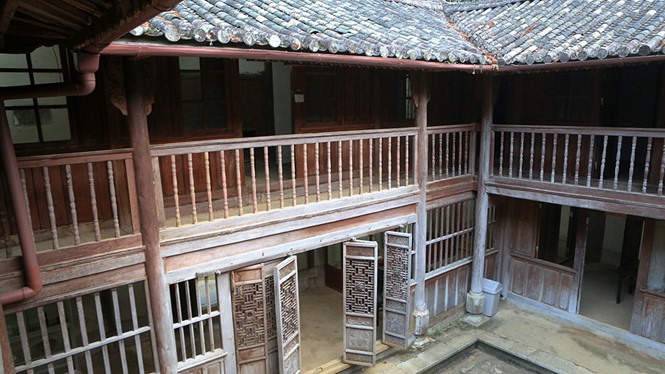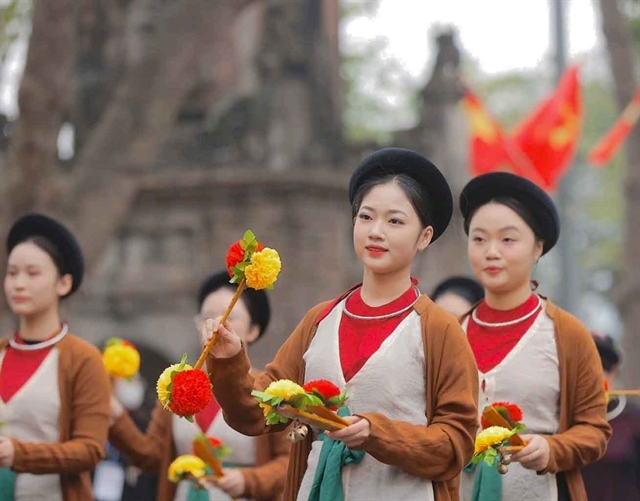 Society
Society

Vương Duy Bảo, grandson of the last Mong King Vương Chí Sình, in late July wrote a letter to the Prime Minister to ask for the return of a century-old palace to his family.
 |
| A view of the century-old palace of Mong King Vương Chí Sình in Đồng Văn District, Hà Giang Province. — Photo thanhnien.vn |
HÀ NỘI — Vương Duy Bảo, grandson of the last Mong King Vương Chí Sình, in late July wrote a letter to the Prime Minister to ask for the return of a century-old palace to his family.
The palace, which was listed as a National Heritage Site in 1993 by the Ministry of Culture, Tourism and Sports, was handed over to the Đồng Văn District’s culture department in 2002 for maintenance.
By that time, six families with 40 people were still living in the property. The big family was given VNĐ500 million for expenses during the period of maintenance.
Since then, the family has been unable to return.
Two months ago, they learned that in 2012, Hà Giang authorities decided to hand over full ownership to Đồng Văn District’s culture department.
In his letter to the Prime Minister, Bảo express his anger and confusion, because according to the culture ministry’s decision in 1993, the family had the right to use and live in the palace, Thanh Niên (Young People) newspaper reports.
Trần Đình Thanh, deputy head of the Ministry of Culture, Sports and Tourism’s cultural heritage department, said that while the government would get priority should the owner of a national heritage site want to sell it, such transactions must be mutually agreed.
In a report submitted to the Government on this matter, Hà Giang authorities said that they wanted to continue management over the palace, without indicating whether the royal family could get it back.
Trần Đức Quý, vice chairman of the province’s People’s Committee, said if the Vương family can prove its legal inheritance of the palace, the palace’s land-use rights would be returned.
Nguyễn Quốc Bình, a lawyer from Long Hà Law Firm, said, legally the identification of the palace ownership had to be based on the inheritance law. In case no legal will exists, the inheritance right belongs to the King’s direct relatives.
With such identification, when the palace was granted the title of National Heritage, profits from business activities related to the palace will have to be handed back to its owners after keeping a certain amount for operation costs, the lawyer said.
While waiting for things to be cleared up, the Mông King’s family still hasn’t been able to return to their home.
Khuất Tân Hưng, a professor from the Hà Nội Architecture University, said it was not rational that owners of private cultural heritages had to move out when the property is listed as a National Heritage Site.
“The value of a heritage site is the combination of the architecture work and the life of those who live in it. Once the owners have to move, much of the value is lost,” Hưng said.
He said that when the family of the Mông King had to move out, the palace is pretty much a dead museum.
“Of course it’s easier for maintenance and preservation, but the core value of the ‘heritage site’ does not remain,” he said.
Hưng mentioned Hội An Ancient Town as a successful model for heritage preservation.
“If Hội An City is merely a museum of ancient architecture without its residents, no one comes to visit anymore,”
Hoàng Đạo Cương, director of the Relics Preservation Institute under the Ministry of Culture, Sports and Tourism, shared the same opinion, saying that local authorities in Hội An had co-operated with residents in preserving the ancient town.
When houses need maintenance, owners would pay 40 per cent and local authorities would pay 60 per cent.
“The city had houses with ages up to 200 or 300 years old, but the nice thing about it is that houses owners are still living there, making it a live museum,” he said.
Meanwhile, Nguyễn Văn Huy, former director of the Museum of Ethnology said the palace of the Mông King was like a dead museum, without real families living in it.
“If the family lives there, it’s cosy and more interesting for visitors. Family members can even work as curators and tell visitors about the palace’s history,” he said.
Irrational regulations
Hưng from the Hà Nội Architecture University, said there are still shortcomings in the Law on Historical Relics, which states that national heritage relics can’t be changed or repaired.
Such regulations can’t be applied to privately owned relics, he said, because problems will arise as time changes.
“What if the relic is degraded? What if the size of a family living in an ancient house increases? The requirement to keep all national heritage relics unchanged is extreme and not rational,” he said.
Phạm Hùng Sơn, head of the village management board of Đường Lâm Ancient Village in Sơn Tây City, said ever since the village was recognised as a national relic in 2005, it had had to follow the heritage law. This prohibits repairs and enlargements to houses, which some residents have found restrictive.
“Younger generations were starting to grow up and start their own families. However, they have to live in the same sized houses because of the heritage law,” he said.
Many residents of the village wanted to “return” the National Heritage Site title to the Government so that they could freely do what they want with their houses, Sơn said.
Hưng from the Architecture University suggested making amendments to the law.
“The state needs to give the rights to owners of private heritage sites so that they could also benefit from their property while helping preserving the site,” he said.
“If the Government is too imposing and irrational, we won’t be able to keep the heritages we want,” he said.—VNS




